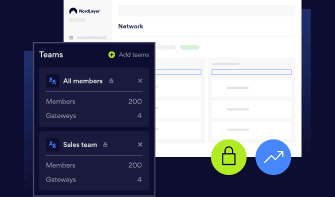Data breaches often make headlines when big companies are involved. But here is the reality: small businesses (SMBs) are frequent targets and face higher vulnerability to cyber-attacks. Their limited security measures, stemming from their smaller size, make better odds for attackers.
This is why small business owners need to focus on cybersecurity. With the right protections, they can secure important data, keep customer trust, and avoid expensive incidents. This article shares simple security tips to help small businesses strengthen their defenses.
Why small businesses must prioritize cybersecurity
Cybercriminals often target small businesses because they may not have strong security. Bad actors take advantage of this to steal important data, like financial information, from the business or its bigger partners.
These attacks are usually about making money and can cause serious problems. Businesses might have to pay for stolen data, deal with disruptions during investigations, spend on new security tools, and handle damage to their reputation.
Understanding cyber risks: insights for small businesses
According to Accenture’s Cybercrime Report, nearly 43% of cyber-attacks target small businesses, and 95% of these incidents can be attributed to human error. Alarmingly, only 14% of small businesses are prepared to face cyber threats, leading to huge financial costs. On average, small companies spend between $826 and $653,587 on cybersecurity incidents.
#1 Train employees on cybersecurity best practices
Digital cybersecurity controls rely on human knowledge and behavior. How employees act when encountering cyber threats is crucial to a small business security setup. That's why it's vital to focus on what is known as the human firewall.
Strengthen the human firewall by teaching employees how to identify phishing emails and malicious links. Invest in employee cybersecurity training to cultivate a security-aware culture within your organization. Educate staff on common cyber threats, phishing attacks, and social engineering techniques, emphasizing the importance of strong passwords.
Remote workers should also understand basic security practices and the risks of using an insecure public Wi-Fi network. Regular training sessions and reminders will help foster a security culture within and outside the organization, also mitigating the threat of using insecure mobile devices.
#2 Conduct a thorough risk assessment
Your cyber security plan should start by assessing the risks your business faces. Timely identification of potential vulnerabilities helps put the risk in perspective and assess the impact of cyber threats on critical data. This is the foundation for all further actions.
A comprehensive risk assessment helps prioritize security efforts and effectively allocate resources. That way, the key areas will be taken care of sooner rather than later, which enables businesses to patch up the weakest points first and then move on to less critical areas. It lays the groundwork for a solid cybersecurity strategy.
#3 Implement two-factor authentication or multi-factor authentication
Small companies need to secure the network edge with robust authentication procedures. Two-factor authentication or multi-factor authentication are the best options here. These methods require multiple identification factors whenever users connect to network assets. This makes it far harder to obtain access illegitimately.
If MFA is too burdensome for employees, consider using it solely for administrator accounts. Alternatively, try user-friendly 2FA options such as fingerprint scanning. Balance user experience and security. But always go beyond simple password protection, as even strong passwords can benefit from additional layers of protection.
#4 Implement a strong password policy
Weak passwords are common entry points for cyberattacks as they're easy to guess or brute force. That's why it's important to make sure that your employees use strong passwords: a combination of uppercase and lowercase letters, numbers, and special characters.
Make sure each account has a unique password. Enterprise password management tools can simplify this process, making it easier to store and update passwords. By using these tools, you can avoid the risk of human error and the temptation to reuse passwords across multiple accounts. This helps safeguard your accounts from compromise in case one of them is breached.
As an extra precaution, even strong passwords should be periodically updated to limit the time when criminals could exploit them.
#5 Keep software and systems up to date
Regularly updating operating systems, applications, and software is necessary to avoid cyber threats, including malicious software.
Keeping your software up-to-date is like putting up a strong barrier against cybercriminals. By regularly updating your software with the latest patches, you're essentially closing the door on potential attacks and data breaches.
Software updates also address bugs and glitches that may affect the software's performance, stability, or functionality. So, in addition to increased security, updates typically include bug fixes that improve the overall user experience and resolve known issues.
#6 Schedule regular backups
Cyber attacks can lead to the deletion of data or system failures that compromise workflows. This makes it vital to back up high-priority data regularly. Use secure cloud services or external locations outside your core network for automated data backup.
The data recovery process should be periodically tested to ensure the integrity and availability of your backups. If this system is effective, it will quickly bounce back from all internal and external threats with minimal downtime.
#7 Encrypt sensitive information
No matter where sensitive information is kept or transferred, appropriate security measures should be in place.
Encrypt high-value data such as personnel records and customer financial information. If you rely on SaaS or PaaS tools, use any cloud data protection tools provided by your cloud service provider.
Use privileges management to limit freedom within network boundaries. Confidential data should only be available to users who need it for their tasks. That way, attackers struggle to access and extract data when a data breach occurs.
Minimize the number of users with administrative privileges. Avoid giving single users the authority to make fundamental network changes.
Consider using data loss prevention tools. These tools track the location and state of important data. They block data transfers to unauthorized devices and log potentially dangerous access requests. DLP could be a sound investment if you handle high-risk and high-value data.
These measures add an extra layer of security and prevent your data from falling into the wrong hands.
#8 Limit access to critical data and systems
Access to sensitive information and critical systems should be provided only on a need-to-know basis. This means that users should have minimum access rights. Elevated privileges should be assigned under special conditions and for separate user account types. Such a setup minimizes insider threats and contains damage in case of a data breach.
User permissions should also be regularly reviewed, ensuring only authorized personnel can access sensitive data over an internet connection. Quickly disposing of inactive and zombie accounts helps clean up your user base and establish that only authorized users can access sensitive data.
#9 Use network security measures
Implementing technological solutions can significantly enhance SMB cybersecurity networks. A robust firewall, antivirus software, intrusion detection systems, and virtual private networks (VPNs) are a good starting point to tighten security around your network perimeter.
The network is the main channel for data exchanges and communication, so its security is key for business continuity. A firewall provides a barrier between your internal network and the internet, while intrusion detection systems can alert you to potential cyber threats. A Virtual Private Network (VPN) encrypts internet connections, ensuring data privacy and protecting against unauthorized access. Meanwhile, antivirus software is a good all-rounder that helps to deflect simple network threats.
#10 Create an incident response plan (IRP)
Being ready for a cybersecurity incident lessens its impact on your business. Besides stopping threats, focus on getting back to normal operations swiftly. This ensures business continuity, treating the cyberattack as just a temporary setback.
To prepare, there are two main areas to focus on:
Calculate risk probability for threats. Include an assessment of where critical data resides. Assign an individual responsible for protecting important data and connecting every resource with risk-reduction strategies.
Create a recovery plan for all critical assets. This should include security scans to
identify malware or virus infections. Document access requests during security alerts and determine whether data loss has occurred.
An incident response plan (IRP) is vital for the prompt and effective handling of cyber incidents. It should also include contact information for key stakeholders, guidelines for containing and investigating the incident, and a plan for communicating with customers and authorities.
#11 Ensure compliance
Stay informed about relevant data protection and privacy regulations for your industry and location. Ensure your business complies with laws such as the General Data Protection Regulation (GDPR) or the California Consumer Privacy Act (CCPA). Compliance helps protect your business from legal consequences and demonstrates your commitment to data privacy.
Regulatory requirements are subject to change, so monitoring their developments should be ongoing. This allows us to be prepared for any relevant changes in advance and align with applicable data protection and privacy regulations.
#13 Manage third parties securely
Small businesses rely on third-party vendors, but these partnerships can be vectors for cyber attackers. For example, CRM providers may not encrypt data securely, putting client data at risk. Virus checkers or low-quality VPNs may transmit spyware.
Check all third parties and ensure they have rock-solid security policies. Trust nobody and always ask for security assurances when in doubt. Evaluate their security practices, including data handling, access controls, and incident response procedures. Establish clear cybersecurity expectations in vendor contracts and regularly monitor their compliance.
#13 Safeguard against physical theft
While protecting against cyber threats is crucial, remember that physical theft of hardware is also a risk. Prevent unauthorized access to business devices like laptops, PCs, and scanners. Secure devices physically and consider adding trackers for recovery in case of loss or theft. Educate employees about the importance of protecting data stored on their devices when outside the office.
For shared devices, establish separate user accounts for added security. Enable remote wiping to delete data on lost or stolen devices remotely.
NordLayer: a tool for small business security
Nordlayer is the ideal partner for small businesses seeking to secure their data. Offering a range of SMB solutions, we strengthen network defenses and streamline employee identity management.
Device Posture checks are crucial for enhancing remote work security. NordLayer's systems evaluate every device connection, ensuring compliance with security standards. If a device fails to meet these rules, access is denied, providing immediate notification to users about access requests from unknown or compromised devices.
IP allowlisting lets you exclude unauthorized addresses at the network edge. IAM solutions use multi-factor authentication and single sign-on to admit verified identities. Virtual Private Gateways anonymize and encrypt data, adding more remote access protection. And our cloud VPN services lock down hard-to-secure cloud assets that small businesses rely on.
NordLayer makes achieving compliance goals easier and provides a safer customer experience. To find out more, get in touch with our sales team today.















